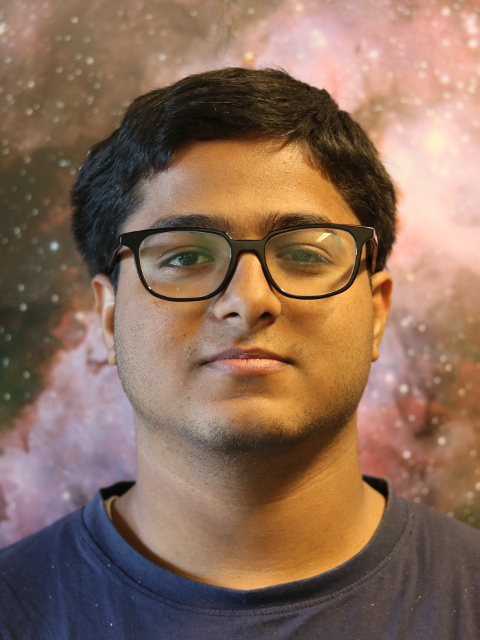Spandan Dash
I am a 3rd year PhD student in the Astronomy and Astrophysics group at the University of Warwick. My supervisor is Dr. Matteo Brogi.
Research
I work on characterizing exoplanet atmospheres using high resolution spectroscopic data in the infra-red wavelength range from spectrographs mounted at some of the biggest telescopes on the planet e.g. VLT, TNG and CAHA. My overall research project is divided into observational and theoretical components.
Part - I (observational and computational)
My aim is to build a python pipeline to analyze data from atmospheres of giant and Neptune/sub-Neptune sized objects. The analysis of such data will aim at measuring their physical (temperature) and chemical (composition) properties which will serve to inform us of the diversity of gaseous planets that can exist and the kind of molecules that can be seen. This will then either match with predictions of theoretical atmospheric chemistry models or bring even more surprises and inform us about possible exotic chemical reactions that might make some specific molecules more or less abundant than expected.
Looking at the diversity of Neptune and sub-Neptune sized objects can also ultimately present an overview of the compositional diversity of atmospheres of such objects with the largest sampling frequency in exoplanet surveys. This will allow us to examine the dichotomy between the more gaseous and/or icy (similar to Neptune and Uranus) and the more terrestrial (rocky or water worlds similar to Earth or Mars) objects, which in turn has the potential to remove the degeneracy in composition that exists for such objects today. Efforts at characterization of atmospheres of such bodies at low resolution are often constrained by the fact that presence of clouds, hazes and aerosols in the atmosphere can result in flat spectra which obscures chemical signatures. High Resolution spectroscopy is expected to still be sensitive to species present above the cloud deck in such atmospheres. Hence, results from high resolution spectroscopic observations by taking cloud modelling, hazes and aerosols into account in our chemical models have the potential to make a massive contribution to understanding this class of exoplanets.
Part - II (theoretical and/or computational)
Planets similar to our own planet Earth are what excites us most since it directly addresses the ultimate question: Are we alone in the universe?
Keeping that question in view, the second part of my project ventures into the simulation of observations of terrestrial exoplanet atmospheres, some of which will be/are expected to be close to our own planet’s conditions. As the ultimate goal of exoplanet research is to assess whether life exists elsewhere than the Earth, these simulations will inform the community on whether it is possible to use the next generation of giant telescopes - for instance the Extremely Large Telescope currently under construction in Chile - to recognise the imprint of biomarkers. Biomarkers are a set of molecules in the atmosphere which are thought to be indicators of biological life. In order to robustly claim their detection, the simulations will also explore whether it is possible to recognise and exclude false-positive scenarios (cases when one or more biomarkers are present in the atmosphere due to processes not related to life).
Publications
First author:
- Dash S., Brogi M., et al. Constraints on atmospheric water abundance and cloud deck pressure in the warm Neptune GJ 3470 b via CARMENES transmission spectroscopy, MNRAS 2024Link opens in a new window
- Dash S., Majumdar L., et al. Linking atmospheric chemistry of the hot Jupiter HD 209458b to its formation location through infrared transmission and emission spectra, ApJ 2022Link opens in a new window
- Dash S., Miguel Y., Planet formation and disc mass dependence in a pebble-driven scenario for low-mass stars, MNRAS 2020Link opens in a new window
Participating:
Teaching
I served as a Senior GTA for the 1st year Physics and Electronics laboratory from 2021-2023.
Scholarship/Funding
I am a recipient of the Chancellor's International Scholarship provided by the University of Warwick.
Conferences, Workshops and Contributions
2022:
- Annual meeting of the European Astronomical Society (EAS) at Valencia, Spain - June 2022 - ePoster
- National Astronomical Meeting (NAM) at University of Warwick, United Kingdom - July 2022 - Poster
- Rocky Worlds II at University of Oxford, United Kingdom - Attendee
- Thinkshop on High Resolution Spectroscopy of exoplanet atmospheres at Leibniz Institute for Astrophysics Potsdam (AIP), Germany - September 2022 - Talk
- UK Exoplanet Meeting (UKEXOM) at University of Edinburgh, United Kingdom - September 2022 - Talk
2023
- Royal Astronomical Society Meeting on High Resolution Spectroscopy of exoplanet atmospheres at Northampton, United Kingdom - February 2023 - Poster
- Planet ESLAB 2023 at ESTEC, The Netherlands - March 2023 - ePoster
- ExoSLAM workshop at University of Exeter, United Kingdom - June 2023 - Attendee
- Exoclimes VI at University of Exeter, United Kingdom - June 2023 - Poster
- UK Exoplanet Meeting 2023 (UKEXOM 2023) at University College London, United Kingdom - August 2023 - Poster
2024
- UK Exoplanet Meeting 2024 (UKEXOM 2024) at University of Birmingham, United Kingdom - April 2024 - Talk
- Exoplanets V at Leiden, The Netherlands - June 2024 - Poster
Seminars
- At the National Institute of Science Education and Research (NISER), India on January 4, 2023 on the topic "Towards probing the atmospheres of colder Neptunes with High-Resolution transit spectroscopy"

